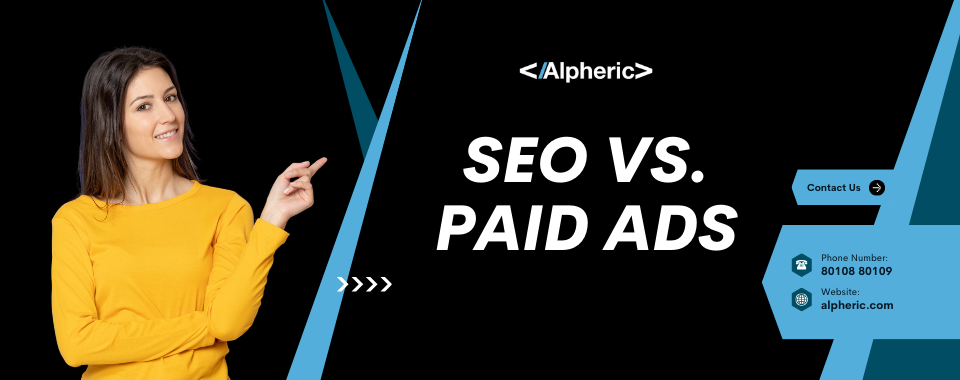As of September 2024, over 1.1 billion websites exist—but only about 17% of them attract consistent traffic. The reason? Many businesses struggle with building strong backlinks, while others fail to target the right audience through ads. This raises a critical question for businesses: Should you invest in SEO or Paid Advertising?
Both methods can produce impressive outcomes—53% of website traffic is from organic search and PPC has an average return on investment of 200%. The secret to determining where to spend is realizing how each corresponds to your goals, budget and business.

Let’s break down the pros and cons of SEO and Paid Ads and explore how combining both can deliver optimal growth.
Understanding SEO and Paid Advertising
Search Engine Optimization focuses on improving your website’s ranking on search engines organically. It requires time and consistent effort but offers long-term, sustainable growth.
Paid Advertising (PPC) allows businesses to display ads directly to their target audience, delivering quick results. However, it requires ongoing investment to maintain traffic.
Here’s a side-by-side comparison of the two strategies:
| Factor | SEO | Paid Advertising |
|---|---|---|
| Cost | Lower cost over time, but requires consistent investment in content and optimization | Can be expensive, with costs depending on competition and goals |
| Results | Takes months to show measurable results | Provides instant traffic and visibility |
| Traffic | Organic traffic from search engines | Paid traffic through targeted ads |
| Control | Limited control over who finds your content | High control over target audience (location, behavior etc.) |
| Scalability | Grows steadily over time | Can be scaled quickly with a bigger budget |
| Brand Building | Builds trust and authority gradually | Boosts brand awareness immediately |
When to Choose SEO
Seo is ideal for businesses focused on long-term, sustainable growth. Studies show that businesses investing in SEO see 13x more ROI (return on investment) over three years compared to PPC-driven models. It’s especially beneficial if your goals include:
- Building Organic Growth: It helps you rank higher on search engines, increasing organic traffic without ongoing ad spend.
- Establishing Authority: Publishing high-quality, informative content positions your business as a thought leader.
- Cost Efficiency: Although It takes time, it costs less in the long run compared to ongoing paid campaigns.
- Long-Term Visibility: Once you rank on search engines, you maintain visibility with regular updates and optimization.
Industries like SaaS, finance and e-commerce benefit significantly from SEO’s ability to drive compounding revenue over time.
When to Choose Paid Advertising
If you need fast results and immediate visibility, PPC is your best bet. Businesses earn $2 for every $1 spent on Google Ads, making it a powerful tool for short-term goals.
PPC is the right choice when:
- Launching New Products: Quickly promote new offerings to a specific audience.
- Competitive Industries: Cut through the competition by securing top positions on search engine results pages.
- Time-Sensitive Campaigns: Promote sales, seasonal offers or limited-time events effectively.
- Precise Targeting: Reach users based on demographics, location and behavior.
Why Not Both? The Power of a Hybrid Strategy
For the best results, combine both to leverage their unique strengths. This balanced approach provides both immediate traffic and long-term growth.
Here’s how a hybrid strategy works:
- PPC for Quick Wins: Drive immediate traffic while building your SEO foundation.
- SEO for Sustainability: Ensure lasting visibility by optimizing for organic search.
- Keyword Insights: Use PPC to test which keywords convert, and then prioritize those in your SEO strategy.
- Audience Retargeting: Capture users who found you through organic search and retarget them with paid ads.
For example, Amazon uses both strategies. While they rely heavily on organic search rankings, they also run PPC ads during major sales events to maximize visibility and conversions.
Decision-Making Framework
When deciding between SEO and PPC, align your choice with your business goals and resources.
Goal: Instant Results
If you need traffic and conversions quickly, prioritize PPC.
PPC is ideal if:
- You’re a new business building brand awareness.
- Timing is critical (e.g., product launches, seasonal sales).
- You want to capture high-intent searchers immediately.
For example, Airbnb used PPC to expand into new markets, targeting keywords like “vacation rentals” for fast traction.
Goal: Budget Allocation
Here’s a structured budget strategy based on business maturity:
| Business Stage | Goal | Budget Allocation |
|---|---|---|
| Early Stage (0-2 yrs) | Lead generation, brand awareness | 70% PPC, 30% SEO |
| Growth Stage (2-5 yrs) | Scale customer acquisition, reduce PPC dependency | 50% SEO, 50% PPC |
| Established (5+ yrs) | Maximize organic revenue, lower CAC | 70% SEO, 30% PPC |
Goal: Targeting Capabilities
SEO targets users through keyword optimization, while PPC provides advanced targeting based on user behavior, location and demographics.
For instance, established brands like Myntra rely on SEO for organic traffic, while emerging brands use PPC to gain immediate visibility.
Measurement and Analytics
Tracking performance is easier with PPC due to real-time analytics. You can measure clicks, impressions and conversions instantly. SEO, on the other hand, requires ongoing monitoring of keyword rankings and organic traffic over time.
Both strategies offer unique insights:
- SEO Analytics: Monitor keyword performance, backlink growth and organic traffic.
- PPC Analytics: Track cost-per-click, return on ad spend and conversion rates.
Which Strategy Wins?
The truth is, there is no one-size-fits-all approach. Successful businesses often use both SEO and PPC in tandem. The right investment depends on your specific business goals and resources.
- For Quick Wins: Choose PPC for immediate traffic and fast conversions.
- For Long-Term Success: Invest in SEO to build sustainable, organic growth.
- For Maximum Impact: Combine both strategies for a balanced, data-driven approach.
With proper strategy to go along, it’s key for digital marketing victory in 2025 to bridge SEO and PPC. The reason is to empower companies to capture a solid competitor advantage while delivering maximum exposure as well as sustaining growth.
Whether it’s SEO, PPC, or both—start optimizing today and watch your growth soar with Alpheric!






